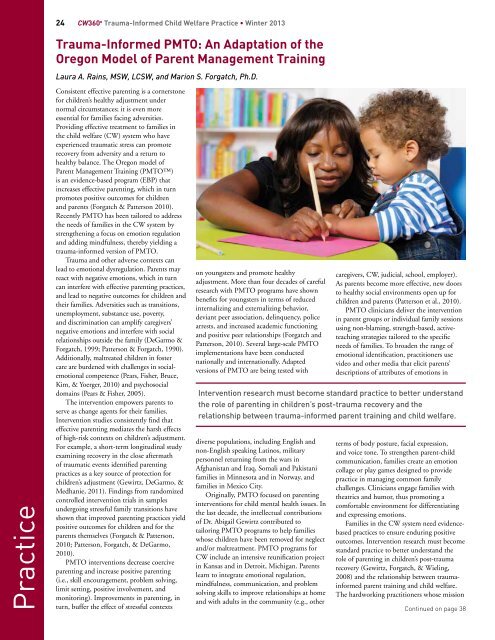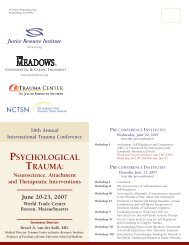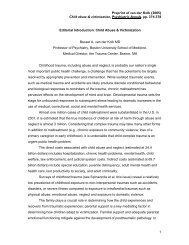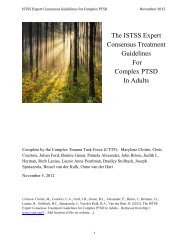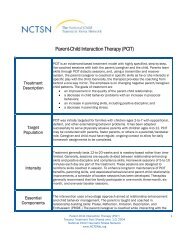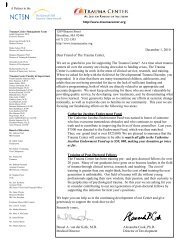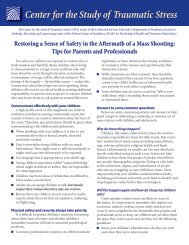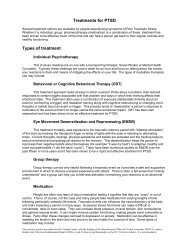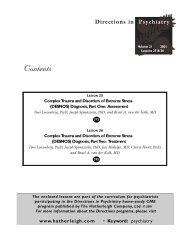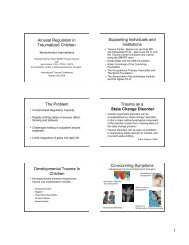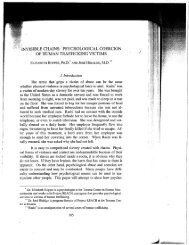in Child Welfare - The Trauma Center
in Child Welfare - The Trauma Center
in Child Welfare - The Trauma Center
Create successful ePaper yourself
Turn your PDF publications into a flip-book with our unique Google optimized e-Paper software.
24 CW360 o <strong>Trauma</strong>-Informed <strong>Child</strong> <strong>Welfare</strong> Practice • W<strong>in</strong>ter 2013Practice<strong>Trauma</strong>-Informed PMTO: An Adaptation of theOregon Model of Parent Management Tra<strong>in</strong><strong>in</strong>gLaura A. Ra<strong>in</strong>s, MSW, LCSW, and Marion S. Forgatch, Ph.D.Consistent effective parent<strong>in</strong>g is a cornerstonefor children’s healthy adjustment undernormal circumstances; it is even moreessential for families fac<strong>in</strong>g adversities.Provid<strong>in</strong>g effective treatment to families <strong>in</strong>the child welfare (CW) system who haveexperienced traumatic stress can promoterecovery from adversity and a return tohealthy balance. <strong>The</strong> Oregon model ofParent Management Tra<strong>in</strong><strong>in</strong>g (PMTO)is an evidence-based program (EBP) that<strong>in</strong>creases effective parent<strong>in</strong>g, which <strong>in</strong> turnpromotes positive outcomes for childrenand parents (Forgatch & Patterson 2010).Recently PMTO has been tailored to addressthe needs of families <strong>in</strong> the CW system bystrengthen<strong>in</strong>g a focus on emotion regulationand add<strong>in</strong>g m<strong>in</strong>dfulness, thereby yield<strong>in</strong>g atrauma-<strong>in</strong>formed version of PMTO.<strong>Trauma</strong> and other adverse contexts canlead to emotional dysregulation. Parents mayreact with negative emotions, which <strong>in</strong> turncan <strong>in</strong>terfere with effective parent<strong>in</strong>g practices,and lead to negative outcomes for children andtheir families. Adversities such as transitions,unemployment, substance use, poverty,and discrim<strong>in</strong>ation can amplify caregivers’negative emotions and <strong>in</strong>terfere with socialrelationships outside the family (DeGarmo &Forgatch, 1999; Patterson & Forgatch, 1990).Additionally, maltreated children <strong>in</strong> fostercare are burdened with challenges <strong>in</strong> socialemotionalcompetence (Pears, Fisher, Bruce,Kim, & Yoerger, 2010) and psychosocialdoma<strong>in</strong>s (Pears & Fisher, 2005).<strong>The</strong> <strong>in</strong>tervention empowers parents toserve as change agents for their families.Intervention studies consistently f<strong>in</strong>d thateffective parent<strong>in</strong>g mediates the harsh effectsof high-risk contexts on children’s adjustment.For example, a short-term longitud<strong>in</strong>al studyexam<strong>in</strong><strong>in</strong>g recovery <strong>in</strong> the close aftermathof traumatic events identified parent<strong>in</strong>gpractices as a key source of protection forchildren’s adjustment (Gewirtz, DeGarmo, &Medhanie, 2011). F<strong>in</strong>d<strong>in</strong>gs from randomizedcontrolled <strong>in</strong>tervention trials <strong>in</strong> samplesundergo<strong>in</strong>g stressful family transitions haveshown that improved parent<strong>in</strong>g practices yieldpositive outcomes for children and for theparents themselves (Forgatch & Patterson,2010; Patterson, Forgatch, & DeGarmo,2010).PMTO <strong>in</strong>terventions decrease coerciveparent<strong>in</strong>g and <strong>in</strong>crease positive parent<strong>in</strong>g(i.e., skill encouragement, problem solv<strong>in</strong>g,limit sett<strong>in</strong>g, positive <strong>in</strong>volvement, andmonitor<strong>in</strong>g). Improvements <strong>in</strong> parent<strong>in</strong>g, <strong>in</strong>turn, buffer the effect of stressful contextson youngsters and promote healthyadjustment. More than four decades of carefulresearch with PMTO programs have shownbenefits for youngsters <strong>in</strong> terms of reduced<strong>in</strong>ternaliz<strong>in</strong>g and externaliz<strong>in</strong>g behavior,deviant peer association, del<strong>in</strong>quency, policearrests, and <strong>in</strong>creased academic function<strong>in</strong>gand positive peer relationships (Forgatch andPatterson, 2010). Several large-scale PMTOimplementations have been conductednationally and <strong>in</strong>ternationally. Adaptedversions of PMTO are be<strong>in</strong>g tested withdiverse populations, <strong>in</strong>clud<strong>in</strong>g English andnon-English speak<strong>in</strong>g Lat<strong>in</strong>os, militarypersonnel return<strong>in</strong>g from the wars <strong>in</strong>Afghanistan and Iraq, Somali and Pakistanifamilies <strong>in</strong> M<strong>in</strong>nesota and <strong>in</strong> Norway, andfamilies <strong>in</strong> Mexico City.Orig<strong>in</strong>ally, PMTO focused on parent<strong>in</strong>g<strong>in</strong>terventions for child mental health issues. Inthe last decade, the <strong>in</strong>tellectual contributionsof Dr. Abigail Gewirtz contributed totailor<strong>in</strong>g PMTO programs to help familieswhose children have been removed for neglectand/or maltreatment. PMTO programs forCW <strong>in</strong>clude an <strong>in</strong>tensive reunification project<strong>in</strong> Kansas and <strong>in</strong> Detroit, Michigan. Parentslearn to <strong>in</strong>tegrate emotional regulation,m<strong>in</strong>dfulness, communication, and problemsolv<strong>in</strong>g skills to improve relationships at homeand with adults <strong>in</strong> the community (e.g., othercaregivers, CW, judicial, school, employer).As parents become more effective, new doorsto healthy social environments open up forchildren and parents (Patterson et al., 2010).PMTO cl<strong>in</strong>icians deliver the <strong>in</strong>tervention<strong>in</strong> parent groups or <strong>in</strong>dividual family sessionsus<strong>in</strong>g non-blam<strong>in</strong>g, strength-based, activeteach<strong>in</strong>gstrategies tailored to the specificneeds of families. To broaden the range ofemotional identification, practitioners usevideo and other media that elicit parents’descriptions of attributes of emotions <strong>in</strong>Intervention research must become standard practice to better understandthe role of parent<strong>in</strong>g <strong>in</strong> children’s post-trauma recovery and therelationship between trauma-<strong>in</strong>formed parent tra<strong>in</strong><strong>in</strong>g and child welfare.terms of body posture, facial expression,and voice tone. To strengthen parent-childcommunication, families create an emotioncollage or play games designed to providepractice <strong>in</strong> manag<strong>in</strong>g common familychallenges. Cl<strong>in</strong>icians engage families withtheatrics and humor, thus promot<strong>in</strong>g acomfortable environment for differentiat<strong>in</strong>gand express<strong>in</strong>g emotions.Families <strong>in</strong> the CW system need evidencebasedpractices to ensure endur<strong>in</strong>g positiveoutcomes. Intervention research must becomestandard practice to better understand therole of parent<strong>in</strong>g <strong>in</strong> children’s post-traumarecovery (Gewirtz, Forgatch, & Wiel<strong>in</strong>g,2008) and the relationship between trauma<strong>in</strong>formedparent tra<strong>in</strong><strong>in</strong>g and child welfare.<strong>The</strong> hardwork<strong>in</strong>g practitioners whose missionCont<strong>in</strong>ued on page 38


